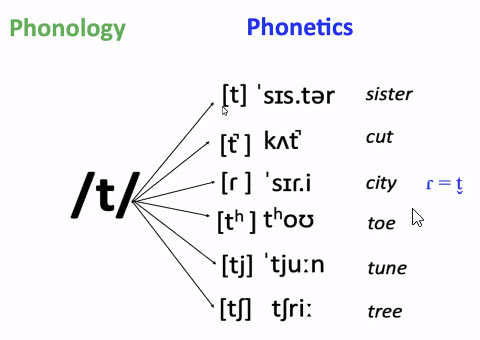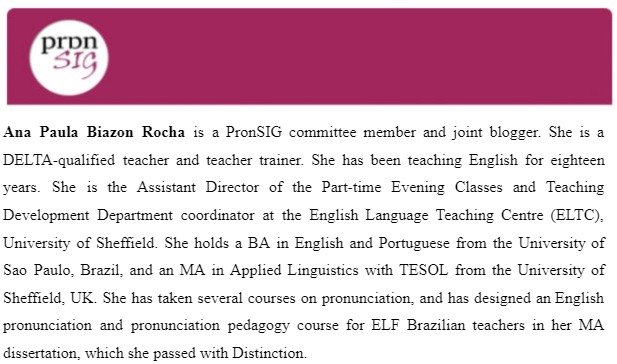by Ana Paula Biazon Rocha
The first PronSIG webinar of 2022 with Thais Cristofaro Silva, ‘How does your mother tongue impact L2 learning?’, focused on answering two essential questions:
1) How does your mother tongue impact L2 learning?
2) How to construct a good pronunciation in L2?
In this post, we will review three of the main points Silva made to answer these questions, so we can try and incorporate them into our pronunciation teaching.
1. L1 transfer into L2 learning
Silva explained that a child’s development of L1 linguistic knowledge happens gradually. First, they spend time ‘noticing’ the language, and then they start speaking it. As for adults, when learning any L2, they will always refer to their L1 knowledge. However, she also clarified that this is not only related to transferring the knowledge they have of the sound system of their mother tongue, and how L1 sounds vary and change into L2, but also neuro-motor activities such as orthographic and pragmatic knowledge. In other words, we do not only take our L1 brain into our L2, but also our body. It is a combination of cognition (brain) and motricity (body), which directly affects how we learn L2.
2. Distinguishing between Phonetics and Phonology
Silva explained the difference between Phonetics and Phonology, reinforcing that while the former is pronounceable, the latter is not. In other words, consider the examples:
- [t̬] shows that this is a flap sound, usually pronounced after the stressed syllable of words such as water and city, in North American English (NamE). This is Phonetics, or how the sound is produced, which is something concrete and physical – notice how the sound is transcribed into square brackets.
- /t/ is a phonemic symbol conventionally used to represent the sound. This is Phonology, which is something more abstract – notice how the sound is transcribed into slash brackets. However, the sound itself can be pronounced in different ways: [ˈwɔːt̬ ər] in NamE and [ˈwɔːt ə] in Standard Southern British English (SSBE).
Unfortunately, there seems to be no convention in dictionaries: some may use the phonetic transcription – in square brackets, whereas others may show the phonemic transcription – in slash brackets. As the phonemic representation does not include the possible ways in which a sound can be pronounced, when learners see /ˈwɔːtə(r)/ in the dictionary, they tend to think that there is only one way to pronounce the sound [t], which is not the case.
This lack of awareness of Phonetics, relying solely on Phonology, prevents learners from noticing that language is dynamic rather than fixed. To put it simply, /t/ is the phonemic symbol but the production of the sound varies:

Image 1: Silva’s example of the difference between Phonetics and Phonology
As a result, learners are led to believe that there is only one correct or standard way of pronouncing sounds in words, allowing no space for variation and change.
Nevertheless, Silva is not telling us to teach students the technical details of Phonetics and Phonology. Remember: they are not phoneticians, they are language learners! We should help them notice the variations of sounds and how they affect our perception and production of the language. According to Silva, next time your student asks you: ‘What’s the correct way of pronouncing the word “water”: [ˈwɔːt̬ ər] or [ˈwɔːt ə]?, try and answer: ‘There are different ways of pronouncing this word’ rather than ‘The correct one is…’
3. L2 pronunciation
Silva suggested that in order to construct a good pronunciation in our L2, one should:
– find a balance between variability and stability: there are certain features which are standard in L2 pronunciation, for example, word stress in English, but there are other things which vary and change, for instance, different possible ways of producing a sound, as mentioned previously.
– rather than trying to sound like someone else, focus on sounding like yourself because only you can sound like yourself!
Therefore, Silva concluded that we should teach pronunciation through the perception that language is a complex and dynamic system. Changes happen according to contextual factors and represent the needs of a certain situation and time. Did you know that the way Queen Elizabeth pronounces the final vowel sound [i] in the word happy, as in Happy Christmas!, has changed over 50 years? Is she right? Is she wrong? Either way, this has happened because the way English was spoken 50 years ago is different from the way we speak it now, and it will probably be different in the future. For teachers and students, this means that we should concentrate on what and how sounds are produced, so effective communication in L2 can take place, instead of labelling them as right or wrong.
For more information, please check the recording of Silva’s webinar on PronSig’s YouTube channel.
Don’t forget to check our previous blog posts with more tips and ideas on pronunciation teaching here. Follow us on social media and leave your comment below.


